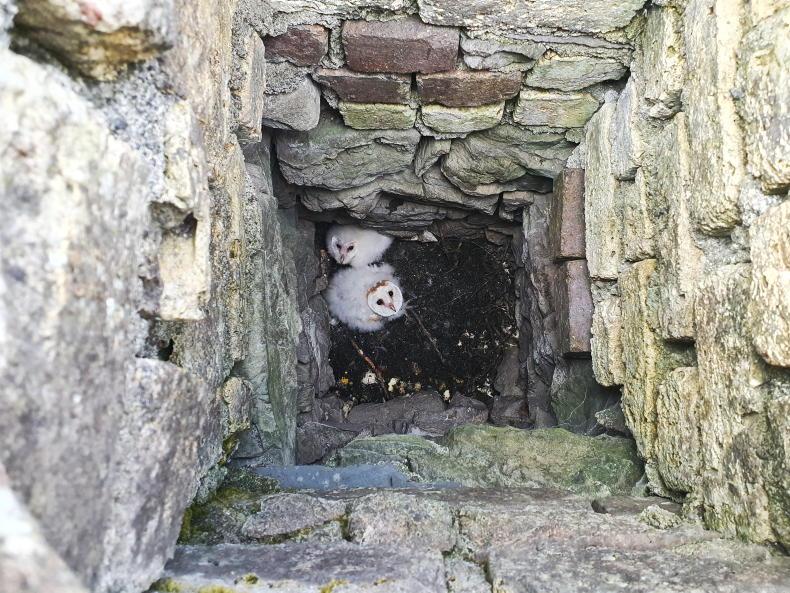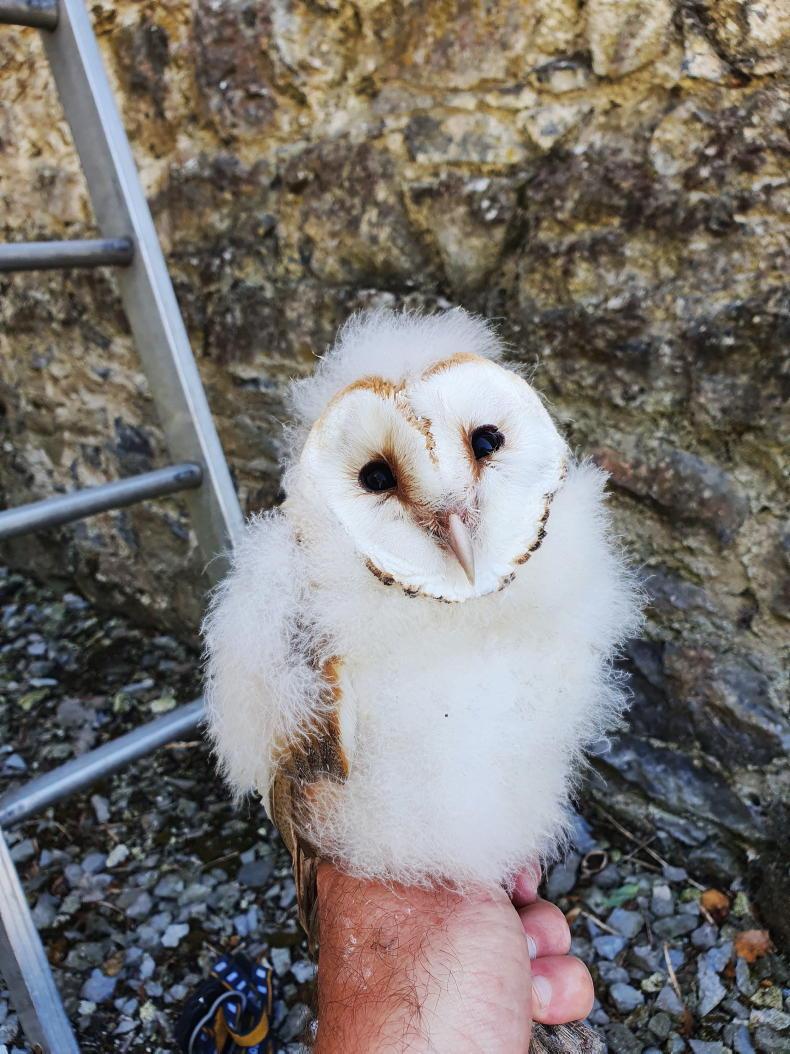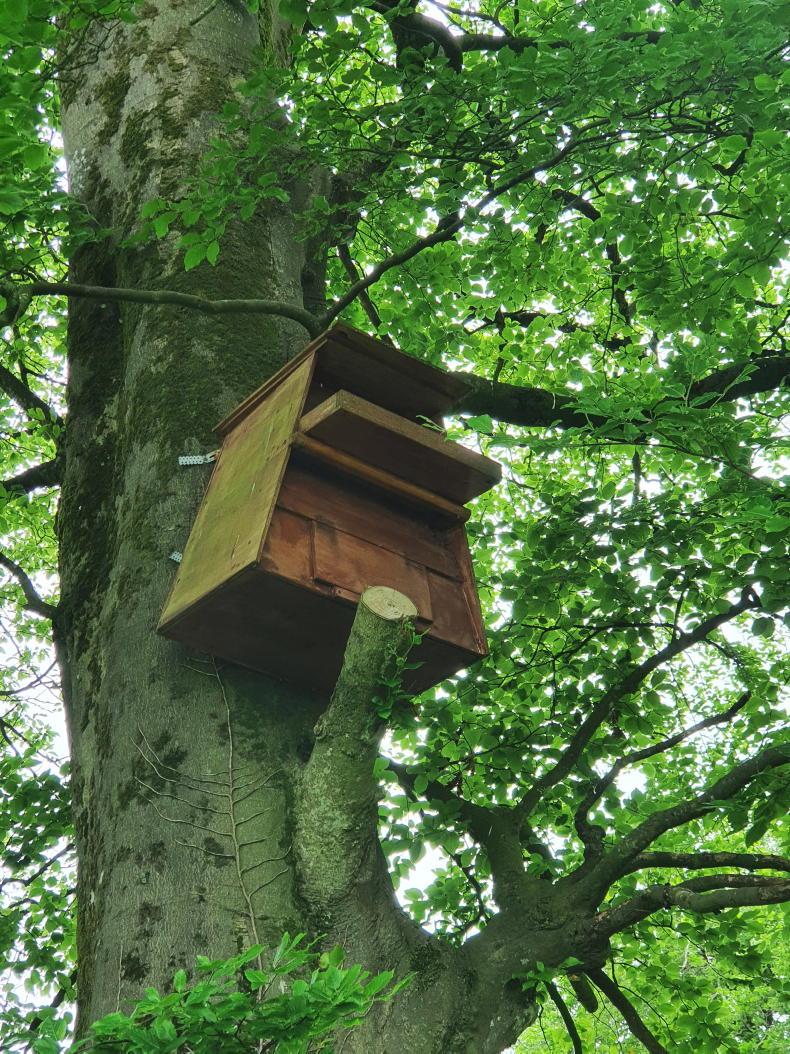The recently announced Agri-Climate Rural Environment Scheme (ACRES) includes a barn owl-specific measure to help address some of the factors which have resulted in a decline in the population of barn owls in Ireland.
The measure requires adopting an integrated pest management approach to reduce the use and effects of rodenticides and to provide a nest box in a suitable location. For this, the farmer receives a payment of €36.48 per unit per year.
The barn owl is a species which has seen widespread decline in both its population and range, and is a red-listed bird of conservation concern in Ireland. It is one of Ireland’s most recognisable birds, and is known as the ‘farmer’s friend’.
Traditionally, it has been closely linked with farming practices in Ireland, and nests in old stone farm buildings.

The barn owl nests in old stone farm buildings.
The provision of nest boxes for barn owls has been a huge conservation success story in the past.
BirdWatch Ireland has recorded over 150 nest boxes which are used by breeding barn owls and this number continues to increase each year.
BirdWatch Ireland has listed practical and easy-to-follow guidance for farmers who are interested in this measure, to identify whether their farm is suitable for this action and to implement it to achieve the best results.
The barn owl action is only available to farmers who meet certain criteria to ensure that the nest boxes are placed in locations that are suitable.
John Lusby of BirdWatch Ireland says: “We have seen that nest box measures in previous agri-environment schemes have not always been implemented appropriately. We have prepared very clear but simple guidance including practical videos on exactly how to implement this measure to get the best results, for farmer and biodiversity.”
In order to determine whether the barn owl action is suitable for their farm, farmers need to consider the following:
Is the farm or potential nest box location more than 500m from a motorway or dual carriageway? This is important as barn owls have often been killed on these major roads. Is the farm less than 300m altitude? Upland areas are less suitable for barn owls, and the majority of nest sites in Ireland are located below 300m.Is there a suitable habitat for barn owls on the farm? To choose this measure, farmers should also choose some of the following measures: grass margins – grassland or arable, low-input grassland, winter bird food, overwinter stubble and unharvested cereal headlands. This is because it is important to provide nest boxes where there is suitable habitat and prey available for barn owls.Finally, is there a suitable location for a nest box on the farm? The nest box must be placed in a location that will encourage barn owls to take up the nest box. 
Young barn owl.
Win-win for biodiversity and farmers
Head of advocacy at BirdWatch Ireland Oonagh Duggan says: “The provision of nest boxes can deliver benefits for barn owls, but also it is important to remember the benefits for the farmer.”
Known as ‘the farmer’s friend’, having barn owls on the farm can help with rodent control, and many farmers that BirdWatch Ireland have worked with who have encouraged barn owls now no longer use or need to use rodenticides.

The barn owl action is only available to farmers who meet certain criteria.
However, providing nest boxes is only one element of addressing the decline in barn owl population.
According to BirdWatch Ireland, the main reason that barn owls, and many other farmland birds have suffered is due to a loss of habitat, and therefore implementing measures focused on restoring habitat will deliver the most benefits.
Providing a nest site for barn owls as well as suitable foraging will help halt the decline in the species.
The guidelines below list some of the habitats available through ACRES which should be linked with the barn owl action, for example, grass margins and winter bird food.
These include grass margins and winter bird food.
According to John Lusby, “this is where we will see real benefits, where the provision of nest sites is linked with changes and improvements in pest management and the provision of a suitable foraging habitat, where these are aligned, barn owls will thrive. It is that simple”.

The recently announced Agri-Climate Rural Environment Scheme (ACRES) includes a barn owl-specific measure to help address some of the factors which have resulted in a decline in the population of barn owls in Ireland.
The measure requires adopting an integrated pest management approach to reduce the use and effects of rodenticides and to provide a nest box in a suitable location. For this, the farmer receives a payment of €36.48 per unit per year.
The barn owl is a species which has seen widespread decline in both its population and range, and is a red-listed bird of conservation concern in Ireland. It is one of Ireland’s most recognisable birds, and is known as the ‘farmer’s friend’.
Traditionally, it has been closely linked with farming practices in Ireland, and nests in old stone farm buildings.

The barn owl nests in old stone farm buildings.
The provision of nest boxes for barn owls has been a huge conservation success story in the past.
BirdWatch Ireland has recorded over 150 nest boxes which are used by breeding barn owls and this number continues to increase each year.
BirdWatch Ireland has listed practical and easy-to-follow guidance for farmers who are interested in this measure, to identify whether their farm is suitable for this action and to implement it to achieve the best results.
The barn owl action is only available to farmers who meet certain criteria to ensure that the nest boxes are placed in locations that are suitable.
John Lusby of BirdWatch Ireland says: “We have seen that nest box measures in previous agri-environment schemes have not always been implemented appropriately. We have prepared very clear but simple guidance including practical videos on exactly how to implement this measure to get the best results, for farmer and biodiversity.”
In order to determine whether the barn owl action is suitable for their farm, farmers need to consider the following:
Is the farm or potential nest box location more than 500m from a motorway or dual carriageway? This is important as barn owls have often been killed on these major roads. Is the farm less than 300m altitude? Upland areas are less suitable for barn owls, and the majority of nest sites in Ireland are located below 300m.Is there a suitable habitat for barn owls on the farm? To choose this measure, farmers should also choose some of the following measures: grass margins – grassland or arable, low-input grassland, winter bird food, overwinter stubble and unharvested cereal headlands. This is because it is important to provide nest boxes where there is suitable habitat and prey available for barn owls.Finally, is there a suitable location for a nest box on the farm? The nest box must be placed in a location that will encourage barn owls to take up the nest box. 
Young barn owl.
Win-win for biodiversity and farmers
Head of advocacy at BirdWatch Ireland Oonagh Duggan says: “The provision of nest boxes can deliver benefits for barn owls, but also it is important to remember the benefits for the farmer.”
Known as ‘the farmer’s friend’, having barn owls on the farm can help with rodent control, and many farmers that BirdWatch Ireland have worked with who have encouraged barn owls now no longer use or need to use rodenticides.

The barn owl action is only available to farmers who meet certain criteria.
However, providing nest boxes is only one element of addressing the decline in barn owl population.
According to BirdWatch Ireland, the main reason that barn owls, and many other farmland birds have suffered is due to a loss of habitat, and therefore implementing measures focused on restoring habitat will deliver the most benefits.
Providing a nest site for barn owls as well as suitable foraging will help halt the decline in the species.
The guidelines below list some of the habitats available through ACRES which should be linked with the barn owl action, for example, grass margins and winter bird food.
These include grass margins and winter bird food.
According to John Lusby, “this is where we will see real benefits, where the provision of nest sites is linked with changes and improvements in pest management and the provision of a suitable foraging habitat, where these are aligned, barn owls will thrive. It is that simple”.











 This is a subscriber-only article
This is a subscriber-only article











SHARING OPTIONS: